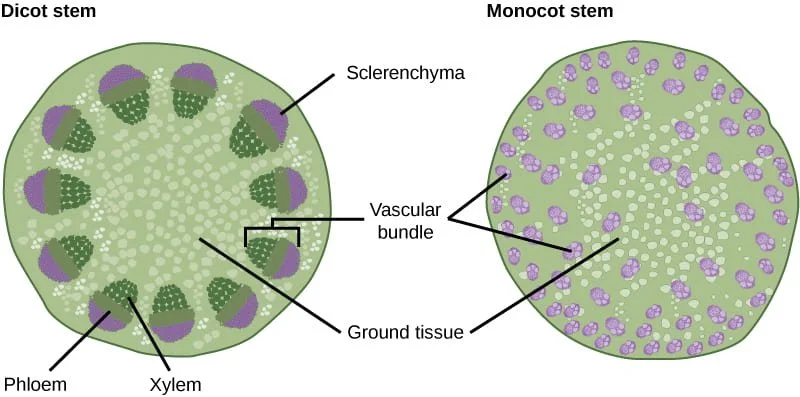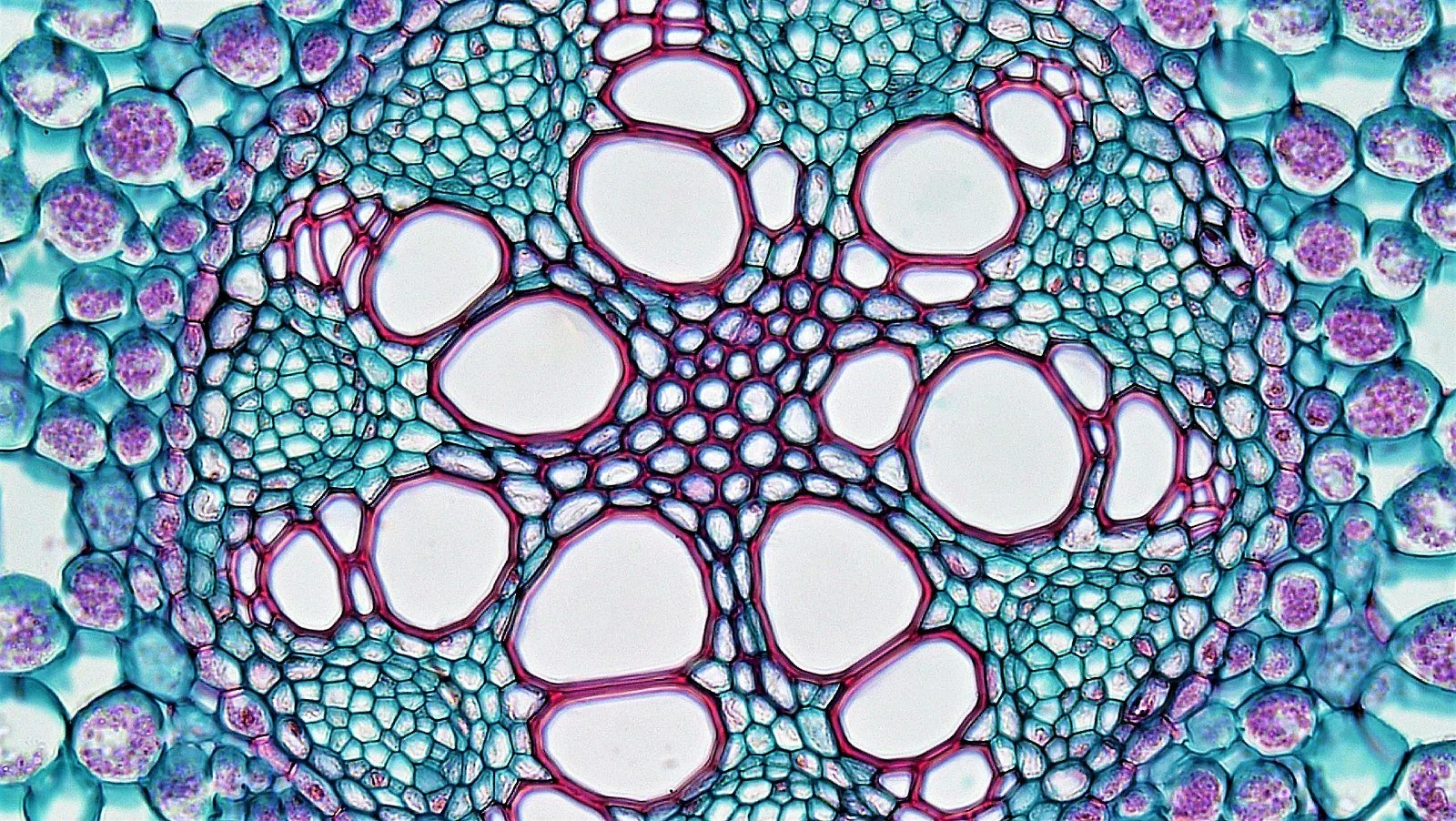Counting seed leaves
Summary
Angiosperms (flowering plants) can be divided into two broad groups: monocotyledonous (monocot) and eudicotyledonous (eudicot) plants. Monocots have long thin leaves with parallel veins, fleshy non-branching stems, flowers whose parts are grouped in multiples of three, and vascular bundles scattered throughout their stems. Eudicots have broad leaves with branching veins, firm branching stems, flowers whose parts are grouped in multiples of four or five, and vascular bundles organised in concentric circles in their stems. The differences between monocots and eudicots are worth understanding because common garden plants can be easily identified as one or the other; and their properties influence how we manage them in the garden.
Plants use photosynthesis in their leaves to generate the energy they need to power themselves. However, when a seed first germinates, the plant has no leaves, and needs a source of energy to allow it to grow them. To this end, a seed contains one or more “cotyledons”, or “seed leaves”, together with sufficient carbohydrates to support their emergence and initial growth. The cotyledons are much simpler structures than “true leaves” (the plant’s eventual leaves), requiring significantly less resources to grow. Once they emerge, they begin to photosynthesise, powering the growth of the first true leaves. Once the true leaves are present, the role of the cotyledons is done, and they fade and die back.
Angiosperms (flowering plants) can be broadly divided into two groups based on how many seed leaves their seeds contain. “Monocotyledonous plants” or “monocots” have a single seed leaf. “Eudicotyledonous plants” or “eudicots” have two seed leaves. Gymnosperms are “multicotyledonous”; depending on the species they may have as few as two cotyledons, or as many as 18.
Why eudicot and not dicot?
Eudicot means “true dicot” and was introduced as a term to replace the name “dicot” based on the results of DNA analysis, which revealed that dicot plants evolved more than once. Plants such as the Nymphaeacea (including water lilies) have two cotyledons and split off from other angiosperms first. Later, plants such as the magnoliids (including magnolias, nutmeg, cinnamon and avocados), also with two cotyledons split off. Next, the monocots split off from the remainder, which itself divided into the eudicots and a group called the Ceratophyllales (including the common aquatic plant known as coontail).
Examples of monocots: Grasses (including food crops such as oats, barley, rice, wheat and maize), alliums, daffodils, irises, asparagus, hyacinths, yuccas, hostas, palm trees
Examples of eudicots: Tomatoes, carrots, hydrangeas, roses, most trees (including oak, horse chestnut, beech, apple, pear, cherry…), salvias, echinaceas, dandelions
If the number of seed leaves were the only difference between monocots and eudicots, this would be a curiosity, but perhaps not worth dedicated an entire article to. However, the differences are much further reaching than this; monocots and eudicots differ in many respects, including their vascular system and their metabolism (the series of chemical reactions that take place within the plant to generate energy and assemble the basic building blocks of life from the nutrients it takes in). Understanding metabolic differences between monocots and eudicots would take us down a very deep rabbit hole, so we will put this aside for now. However, this is why selective weedkillers are able to kill weeds in a lawn without damaging the grass; they interfere with the metabolism of (eudicot) weeds without impacting that of (monocot) grass.
Visible differences between monocots and eudicots
Cutting a seed open to count seed leaves would be a destructive means of determining whether the plant is a monocot or a eudicot (and for many seeds would require a microscope and specialist cutting tools). Fortunately, there are various external characteristics that usually enable a simple determination.
Leaves
Monocot leaves are usually long and thin in shape with their veins running lengthways in parallel. Eudicot leaves vary significantly in size and shape, but are usually broader and shorter, with their veins forming a branching pattern. Monocot leaves are usually isobilaterally symmetrical; meaning that they can be cut in half symmetrically in two different ways (along the length of the leaf, either parallel to the leaf surface, or perpendicular to it). Eudicot leaves are usually different on the top and bottom surfaces, so have only one such symmetry. Monocot leaves are usually oriented parallel to the direction of incoming sunlight; whereas eudicot leaves are usually oriented perpendicular to this direction.
Stems
Monocot plants usually have fleshy stems that do not branch, and when examined closely, do not have epidermal hairs (trichomes). Eudicot plants have branched stems that are generally harder and more rigid, and when examined closely, usually have epidermal hairs.
Flowers
The parts of monocot flowers are usually organised in multiples of three (for example, a daffodil has six petals). Those of eudicot plants are usually organised in groups of four or five. Monocot flowers are usually wind-pollinated; those of eudicots are usually insect-pollinated.
Roots
Monocot roots are usually fibrous, and are adventitious, meaning that they grow from non-root tissues in the plant. Eudicot plants often have a taproot system, and grow from a single base root (which itself develops from the seed root or “radicle” in the embryo of the plant).
These factors should be considered together when assessing whether a plant is a monocot or a eudicot. For example, Heuchera spp have fibrous roots, but have clearly branched stems and complex leaf shapes with branching veins; they are eudicots, not monocots as might have erroneously been determined if based on the root system alone.
Other differences between monocots and eudicots
The more important differences between monocots and eudicots are less easily visible.
Seed structure and germination
The purpose of cotyledons given at the start of this article only really applies to eudicots. Their seeds contain the two embryonic cotyledons and a small energy store (the “endosperm”). As the seed germinates, the cotyledons are pushed rapidly above ground (so called “epigeal germination”) to allow photosynthesis to take place and true leaves to develop. In monocots, the endosperm is much larger, and the cotyledon emerges below the surface, protecting it from frost (“hypogeal germination”). The larger endosperm allows the stem to grow, eventually pushing up through the ground. The cotyledon, although still referred to as a seed leaf, doesn’t so much fulfil the function of a leaf; instead absorbing stored food from the endosperm, and forming a protective cap for the stem and true leaves as they emerge above ground. In this sense, it is not so much the number of cotyledons that distinguishes monocots and eudicots, but the manner in which they develop from seeds (however, there are eudicots that experience hypogeal germination, such as peas and mangos).
Pollen
A plant’s pollen has a complex structure, which includes furrow and ridges. A monocot’s pollen has a single furrow or ridge, whereas a eudicot’s pollen has three or more. This is in fact how eudicots are differentiated from other dicots that evolved earlier (see note above); non-eudicot dicots, like monocots, have pollen with only a single furrow or ridge.
Stomata
Monocot leaves have stomata (pores to allow exchange of gases with the atmosphere) on both surfaces of the leaf. Eudicot leaves usually only have stomata on their lower surface.
Vascular systems
The vascular systems of monocot and eudicot plants differ in both structure and composition, in both stems and roots.
In the stems of eudicot plants, the vascular system consists of bundles of xylem and phloem tissues (see this article), separated by vascular cambium, which enables secondary growth (or thickening) of the stems. These bundles are arranged in concentric circles, with the phloem tissues on the outside. In monocot plants, the tissues are still arranged in bundles of xylem and phloem tissues, but there is no vascular cambium (stem thickening in monocots takes place through different mechanisms), and the bundles themselves are scattered throughout the stem with no discernible pattern.
In the roots of eudicot plants, xylem tissues are arranged radially from the centre of the root, with phloem tissues arranged between these radial structures, separated by vascular cambium. In monocot plants, xylem and phloem tissues are still arranged in vascular bundles, and form a ring with phloem on the outside.
Arrangement of vascular tissues in a eudicot root (large white cells are xylem, small blue cells in between are phloem)
Image attribution: Berkshire Community College Bioscience Image Library. Public domain.
Other differences
The classification of angiosperms into monocots and dicots represents an early difference between these two groups in evolutionary terms, estimated to have happened around 200 million years ago. Since that time, significant differences have evolved in the anatomy and function of various tissues within the plants. The differences discussed in this article are really only the most easily observed, and many other differences exist.
Why know the differences between monocots and eudicots
In order to understand how plants work, it is helpful to classify them by their common properties. At the highest level, this meant identifying the differences between vascular and non-vascular plants; between those that reproduce by spores and those by seeds; and between those that bear flowers and those that do not (article here). The division of angiosperms into monocots and dicots allows the different properties of these groups to be understood.
As classifications get finer, the differences between the properties of each group become more and more technical in nature, and of interest only to specialists (albeit sometime of great importance - for example in understanding the different properties of food crops and how they might adapt to a changing climate). The differences between monocots and eudicots are helpful in understanding the different behaviour of plants in our gardens; and at the same time, are not excessively technical in nature.
Beyond this point, Getting Dirty will not look at the underlying differences between further classifications, but will instead only look at relevant properties. For example, a further classification we will look into is the division of plants into families. Understanding the common properties of such families can help to minimise issues with disease, for example; but a detailed discussion of the differences between families at a fundamental level would require years of study.


